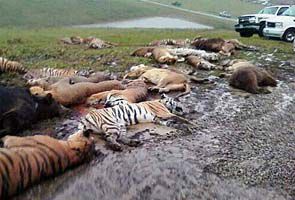The upcoming Red Book list on endangered species features two noticeable absences — the Amur tiger and the gray whale.
Other changes in store for Russia’s Red Book, which is updated every 10 years, include the coordination of its data with the International Union for Conservation of Nature’s Red List and a more objective approach, Izvestia reported.
The Red Book is coordinated by the A.N. Severtsov Institute of Ecology and Evolution, which acknowledged that the previous list included many animals that didn’t belong.
Work on the book won’t be completed until November, but among the animals that may leave the list is the black crane, the Amur tiger and the gray whale.
The decision is a result of both an increase in the species’ numbers and new standards for including animals that come as a result of merging the Russian and IUCN standards.
Valentin Ilyashenko, who is leading the project, said the number of Amur tigers, also known as Siberian tigers, has remained stable for about 15 years and that the big cats are even beginning to expand their territory.
Gray whales, a group of which have a migration route near Russia’s Pacific coast, have made an even more dramatic recovery, with numbers increasing to an estimated 30,000 worldwide from a low of 2,000.
Ilyashenko cautioned, however, that removing species from the list may pose new dangers for the animals. In the case of the gray whale, the responsibility for its preservation would shift from the Natural Resources and Environment Ministry to the Federal Fisheries Agency, which he said may decide to allow the animals to be hunted.
Cette décision est envisagée après le recensement des tigres de l'Amour effectué cet hiver. Les résultats officiels seront publiés dans le courant de ce mois. Les effectifs sont d'ores et déjà considérés comme stables par les écologues, et l'objectif de 600 individus pour 2022 est jugé parfaitement réalisable (Voix de la Russie du 19 mars).
Le recensement des tigres se fait traditionnellement en hiver en observant des traces laissés. Seize zones avec presque 250 itinéraires ont été déterminées afin de faire le recensement. Les recensements précédents des tigres de Sibérie en Primorie et dans le territoire de Khabarovsk ont donné presque les mêmes chiffres, entre 450 et 500 d'individus.
Augmenter la population des tigres de Sibérie jusqu'à 600 individus d'ici à 2022, est tout à fait possible, affirme le biologiste russe Valery Schmounk de la Société Géographique Russe. C'est un nombre optimal pour la population de cette sous-espèce peuplant la taïga russe.
« La population du tigre qui est un animal carnivore, ne doit pas être trop importante. Le nombre d'individus existant aujourd'hui est en fonction de la capacité du milieu de vie à nourrir un tel ou tel nombre des paridigitidés et donc des tigres qui en mangent ».
Dans le calcul des limites de la population maximale des tigres il est tenu compte des « questions de logements » : un mâle adulte a besoin d'un territoire s'étendant sur
presque 1 400 m².
Dans la taïga le tigre chasse principalement dans les forêts de cèdres et de chênes. Si auparavant ces forêts ont fait l'objet de coupes quasiment incontrôlées, aujourd'hui leur destruction barbare est stoppée. Cela veut dire que les tigres pourront se cacher des braconniers et avoir plus de nourriture, explique Iouri Darman, président du bureau du Fonds mondial pour la nature (WWF) à l'Extrême Orient.
« Nos études ont révélé que la coupe commerciale des cèdres à l'Extrême Orient avait été enrayée l'année dernière. La taïga est donc devenue moins dangereuse pour le tigre. L'année dernière il y avait beaucoup de pignons ce qui veut dire que les sangliers avaient de quoi se nourrir. Nous attendons donc une augmentation de la population des tigres ».
Une autre mesure importante pour protéger cette espèce est la création de parcs nationaux. Il y en a, d'ailleurs, un qui est en train d'être créé au sud-ouest du Primorie, poursuit Iouri Darman.
« Deux parcs existent déjà dans cette zone et nous sommes en train de créer sur leur base un parc national plus grand, Zemlya Léopardov (Terre des Léopards). Il s'étendra sur presque 70 kms le long de la frontière chinoise ».
En avril nous connaîtrons le nombre exact de la population des tigres de Sibérie dans la taïga russe. Il n'y aura pas de mauvaises surprises, sont convaincus les écologues. Mais dès aujourd'hui nous pouvons affirmer que les effectifs sont stables."


